"Zay beelong ere Mozambique." |
François Truffaut's mangling of the English language
to unintentional comedic effect (it should read
"They belong here more than we.") |
A Close Encounter of the FIRST Kind: Sighting
A Necessary Introduction:
Close Encounters of the Third Kind was released in the US in November 1977 and the UK, March 1978 – back in the days when it was usual to stagger global distribution. In the UK, it was normal to wait six months for the latest box office behemoth. Now, to a great many people, 1978 is a year with no significance because it was one of many years that occurred before they were born, damn their youth! But get this. Computer generated imagery was a decade away (and even then, it was the crudest of its kind to boot – bad pun, live with it). What Close Encounters did was create a spectacle that was entirely generated by extraordinarily talented craftsmen and women, featured meticulous and artful models, matte paintings and necessitated multiple passes onto the same film negative. All CE3K's FX shots were shot on Vistavision's 65mm negative so that when they were integrated into the standard 35mm, they seemed grain consistent and not grainy as hell as they would have been if shot on standard 35mm and then optically printed to hell and back. You need to know this to appreciate the film in some, if not all, of its glory... If it's in the movie, it's 'real'. Appreciate. And maintain that sense of wonder...
For those seventeen people unfamiliar with the film, CE3K is about an electricity line repairman, Roy Neary, who gets sunburned at night by bright lights in the sky. Chasing UFOs, he meets Gillian, whose son Barry was drawn to the lights. Implanted in Neary's mind is the image of a summit-chopped-off mountain. His family life falls apart because of his obsession with the lights and the mountain. Barry is kidnapped by the lights in the sky. Implanted in his mother's mind is a five note melody as well as the mountain. On TV, there is a news story announcing an evacuation in Wyoming because of a chemical accident. The mountain is seen on the TV and Roy and Gillian make their way there and find each other. The government round up those drawn to the mountain but fail to stop Roy and Gillian. They witness a landing strip on the other side of the mountain where the lights reappear (alien space craft) and after a little while something utterly magical and extraordinary happens...
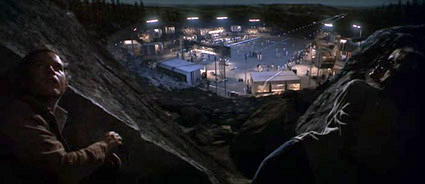
After revelling in his wonderful Jaws, (that sounds faintly psycho-sexual in nature – please understand that the phraseology was an unhappy accident) I waited for the next Steven Spielberg film, a wait that was to be a sublime torture. I was 14 years old, impressionable as warm clay and ravenous for significance. But Spielberg dropped off the radar in a way that would be impossible today. All in the name of secrecy (remember secrecy? Very big in the 70s), he had disappeared so completely for two years that someone claiming to be him on the US's East Coast was dining out on people's gullibility and the massive success of 'the fish movie'. How was I to know the real Spielberg had gone to ground to write and direct what for me remains the greatest cinema experience of my life? A big claim. Yeah, I know. But I was there and the memory is fresher than air on a Wyoming hillside. In some ways my total (one might say passionate) embrace of CE3K was utterly inevitable.
The first film to truly damage me was Pinocchio at the age of 6 (I was 6, not Pinocchio). Let's not count the thunderstorm in Bambi during which I had to be manually ejected from the cinema because I was screaming so loudly. I'm not counting this because my mother told me this story and I submit she may have been an unreliable witness. I mean she went into labour with me in a cinema watching Ben Hur. She was in the cinema, not me... I'll stop this now but it is a true story. In Pinocchio, seeing Lampwick change into that donkey after smoking and drinking was a warning of such moral power that the church should have taken notes. The second film to really allow my mind to dare to imagine our role in the cosmos was Kubrick's sublime 2001 A Space Odyssey. And I was only 10.
Now let's see. Take the wooden boy and Kubrick's star-child, shove them in a benevolent blender and what comes out is Steven Spielberg's truly magnificent Close Encounters. Pinocchio is even name checked in the first Neary family scenes of the movie. Of course my feelings have changed towards the film-maker (things like that happen over more than 30 years) and in some senses the movie itself but that experience all those years ago – a treasured memory, a nod to the movie gods and proof positive that cinema was an art form that could touch one's soul (and all these airy fairy words from a rabid non-believer).
Starburst, the hallowed magazine that enabled both Slarek and I to attend an early sneak preview of Blade Runner in 1982, ran a review of CE3K in their second issue (reprinted from the L.A. Times, I understand). If I had known the scale of what I was looking at in the published photos and was able to interpret the image correctly, a fair amount of the climax of the film may have been ruined. Accompanying the review was the blood red tinged shot of the mothership creeping out from behind Devil's Tower. Today's equivalent of that pictorial spoiler would be a full frontal of J.J. Abram's Cloverfield monster, alien or otherwise. But it was reviewer Ray Bradbury's unbridled and fervent love of the movie that hooked me mightily. Here was a respected and rather great science fiction writer singing the praises of the man who directed Jaws and his follow up movie. Just to give you a sense of the evangelical zeal of the review, here are a few tasters...
"'Close Encounters of the Third Kind' is the science-fiction film we have all been waiting for. In fact, we were waiting for it before we were born. The ghost in us, the secret stuff of genetics, was waiting. The Life Force was waiting, waiting to be born, truly for the first time."
"'Close Encounters' is, in all probability, the most important film of our time. Do I bite off too much of the Universe, take more than I can chew? I think not."
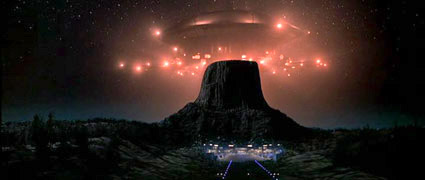
Now, the cynics out there may quite rightfully point out that I had been primed for a near religious experience and that's just what my mind delivered to myself. Believe it or not (you may as well believe it as it's true), this is the first time I have considered that Bradbury's words may have primed me. Writing for Outsider saves a fortune on psychiatrist's fees. But... As a thoughtful teenager, part of me was hard wired to dismiss religion as an explanation of the world and another part of me was so open to spiritual enlightenment it was almost embarrassing. Back then, I couldn't believe it wasn't Buddha. As teenagers, weren't we all looking for 'it'? Weren't we all so two dimensional at that age (seeking that elusive third) that we would not have been out of place on South Park? My English teacher at the time remarked that 'friendly aliens' was just another religion to be worshipped. I balked at that. I didn't want to worship something. In the end, I experienced something like a profound awe in my first viewing of this film. I had never experienced an emotion like it before or since – cinema or no cinema.
A Close Encounter of the SECOND Kind: Physical Evidence
"One of the most beautiful things in the cinema..."
Gavin Millar, producer and host of BBC's
Arena Cinema, 1978 on Close Encounters
If I could name an experience akin to what happened to me at about 1.00am on Sunday the 2nd April 1978, then I probably wouldn't be able to spell it. But I will say this with a chill in my heart; who knows what kind of a person I would have turned out to be if I'd had that experience in a church? Or – rather more crucially – interpreted that experience with the only epiphany-iconography open to me – a loin-clothed guy nailed to a tree (as opposed to a city-sized space ship with friendly ETs). I got into an interesting argument with a friend recently who called me arrogant for disrespecting her friend's recent conversion to Christianity after a 'religious experience'. My arrogance was fuelled by the odd idea that any so called 'spiritual experience' (even the real thing whatever that actually is) may only be narrowly interpreted through the colander of Christianity. It's like being hit from behind by a brick. Born Agains always seem to know what colour the brick was when there are nine million colours to chose from. "Oh, I see the light..." Therefore it must be God, Jesus and the whole ludicrous shebang of middle ages' superstition. Uh... No. Irony alert – it could be something even better! A city of lights that floats!
The sneak preview of Close Encounters of the Third Kind was on at Cardiff's Odeon cinema (bless you, Steve Utley) at 10.45pm. It was the eve of my 17th birthday. I was first in line at 10.00pm. I was so excited, giddy with what might be to come. I was also bleeding and wondering just how in the hell I was going to get home. I'd had an accident on my moped that evening (never let your enthusiasm for a movie send you over the handlebars of your preferred mode of transport or in this case, yes, let it, goddamnit) and that had resulted in a slight but open wound, a broken and momentarily unfixable bike and an awkward call to parents; "Dad, could you come and pick me up at about 1.30am?" Bless him, he did just that. Aren't fathers – fathers who understand the irrationality of cinematic passion – just the best?
I can't remember the popcorn and sugar water moments but I do remember my first exposure to the movie. Dolby was a new word in those days and Star Wars had trumpeted it loudly. Close Encounters was about to redefine what a soundtrack could add to a cinematic experience. John Williams' music was extraordinarily evocative and after that first frame of picture to that orchestrated crescendo (a single flashed white frame as a shock effect if anyone's interested) I was hooked. For some insane reason I felt (as it unfolded) that Spielberg had addressed the film directly to me. I know how fan-nish and naïve that thought was (because everyone else who enjoyed the film was having those thoughts too) but it did not diminish the experience.
Permit me a small personal indulgence, one of those remarkable coincidences that folks sometimes start attributing to divine intervention. For my 17th birthday my parents allowed me to paint the walls of my bedroom black (cinema-like, you understand). A small patch of white stood out, on which I would project my 8mm movies. But, preparing to leave to see CE3K, I gave in to an instinct to mark my territory. I put up a poster, a Snoopy poster on which the caption above the dog said "It doesn't matter if you win or lose... until you lose!" It had an orange background. I thought nothing of it.

A few hours later I was watching Richard Dreyfuss pulling up pot plants to lend some verisimilitude to his 3D model of Devil's Tower (in his living room). The kids and his wife were a little surprised at his behaviour but not as bloody surprised as I was. We individual members of the public imbue coincidences with significance. Well how's this? On the Neary children's bedroom wall was the exact same poster I had put on my wall a few hours earlier. It felt like Spielberg had reached into my head (from a time machine) and placed that poster there so I could marvel at the inner machinations of the universe. Reviewer, Ray Bradbury didn't mention that in his review. God, I'm so glad I didn't take this as 'a sign'... Maybe I did.
What Spielberg was promising as a climax seemed too much of a good thing. There was no way that even the director of Jaws could deliver what the bulk of the movie had been promising for 90 minutes. We were at Devil's Tower. How could he possibly end this movie without some profound sense of anti-climax?
Isn't it delightful being so totally and unutterably wrong?
So we were at the mountain. Spielberg had cunningly led us willingly to the place where miracles might happen. What was truly groundbreaking was the fact that whichever way you interpreted his signposting and cinematic teases, the climax is really given away in the title. "Close Encounters of the Third Kind" is a simple euphemism for "We meet aliens". So I knew we were going to meet aliens and was curious how a man famous because of us not seeing too much of his giant polyurethane fish would pull off aliens. I mean, even Kubrick balked at showing ETs front and centre. Extraterrestrial presence in 2001 is mostly aural effects. There has only been one sublimely convincing alien on screen for my money and that's your actual Alien's 'alien' but no one's going to perform musical hand signals with that bastard. But being on the other side of the mountain, Spielberg had something else to show us before we actually met them.
At first, the rumble is felt not heard. As it rises in intensity, it's the sound of a sub-woofer the size of a bus with a head cold. Shadow lines start doing some serious passing overhead and we are afforded glimpses of what looked like a mighty disc encrusted with age-old (oil re)-finery. Williams starts to signal a crescendo coming. The shock of the first wide shot is nothing short of breathtaking – the SIZE of that thing...
And no one, no one even considers why the ship is actually travelling up from the ground and not down from the sky. All we can do is stare and wonder how such an extraordinary sight could possibly be presented to us. We go back to glimpses and reactions. "Mince Alors!" says the friendly government official, Claude Lacombe (François Truffaut) who was not talking about ground meat or Christmas pies. One guy almost knocks Neary (Richard Dreyfuss) over in his dash for the Portaloo while a city sized mothership floats overhead. Another two views of its underside and...
Cut.
The reveal. Williams' cue is now spent. It has orchestrated its "Taaa daaaar!" The enormous disc with a lit cityscape beneath it, rotates gently and the top of the disc, which lights up spectacularly (Spielberg's San Fernando Valley nod), comes to a gentle landing. That, ladies and gentlemen, is my cinematic epiphany. I had no idea anything could be so glorious and my heart filled with disbelief and a wonder I have never managed to recapture in the cinema. I left the Odeon that early morning looking up at the stars and whispering over and over "I don't believe it..." I really did though. I queued for all three performances the next day and managed to see CE3K 29 times in the cinema before it exhausted its run.
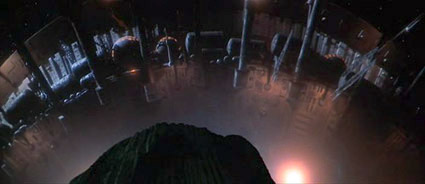
And later in life (after I annually celebrated not my birthday but the eve of my birthday from then on) I read that people chose their favourite films between the ages of 16 and 18 (I fit there very snugly). Had I been primed by a rapturous review, delivered myself a cinematic religious conversion and then blandly submitted to the statistic of normality? I didn't give a tinker's cuss (what actually is a tinker's cuss?) then and to be honest, as amenable to my memories as I believe myself to be, I don't give one now either. I was enchanted in 1978 by the sight of a metal and plastic model no more than four feet wide, lit to buggery and shot in a room so filled with smoke it probably would not be allowed today. Can you imagine? The imagination of Steven Spielberg scuppered by Health and Safety. No. This was different. This was a knocking on the door of my subconscious and my being stunned that it actually opened and invited me in.
A Close Encounter of the THIRD Kind: "...is really when you meet 'em"
"Today I would never have the guy leave his family
and go onto the mother ship. Today I would
have the guy do everything he could
to protect his children."
Director/Writer Steven Spielberg (now more mature and becoming even
more obsessed about alerting the world to his fatherhood status)
Aliens. How do you present aliens in a realistic fashion? These are benign creatures who've popped down to Earth to say hullo, kidnap, return and awe its ape descendants. The first true ET we see in CE3K is a skeletal giant who has to lean down to get out of the ship. He stands and Williams' score screams "Be In Awe!" OK. Then the smaller folk turn up (kids in ET costumes) but Spielberg gets away with it. Why? Light. He doesn't only see the light, he gets Vilmos Zsigmond (his extraordinary cinematographer) to flood the mothership opening hatch with enough light to illuminate a football field. It is almost impossible for the ETs to be seen in an earthly fashion. Their light, their rules. If the film showed the ETs in the same light as shown by behind the scene stills of the kids in normal light, the movie would simply not have worked. Editor Michael Kahn and Spielberg admit that nothing in their careers had been, before and since, harder to cut than the last 30 minutes of CE3K. I can well believe them. There are several oddities. Long limbed, translucent stick ET opens his arms wide and in two cuts he's disappeared. The big close up, Spielberg's ultimate encounter of the third kind, is with a severely backlit, bleached out animatronic model made by ET creator, Carlos Rambaldi. Its movements are stiff and its smile mawkish but that light almost makes it work. I didn't buy the ETs but I was so awed by the mothership, I would have forgiven Spielberg ETs that looked like kids with big head masks – hold on...
Spielberg had guts. His entire movie rocket was supported by a gantry requiring the ultimate suspension of disbelief. The mothership was so extraordinary that the aliens themselves could not have trumped it. They did what we needed them to do. They took Richard Dreyfuss and cuddled him forward. The moment he looks back and then places his first foot on the shiny ramp is one in which John Williams passes out with awe. He's awed out. That piece of music, for many years, was my ultimate in film scoring – an emotional accompaniment to a sublime moment that could not be beaten or questioned – until I got a job as Richard Franklin's assistant on a feature in the eighties. He waved away 'Camus' greatest film music ever written' with a simple word; "Debussy..." And that's when my musical education really began.
Despite that particular coming back down to Earth, Steven Spielberg's Close Encounters of the Third Kind will still be the film that defined the power of cinema to a teenager who just – at the time – simply couldn't believe it.
*
A Personal Postscript
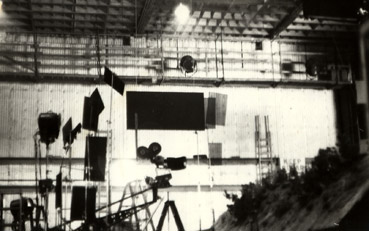
I was lucky enough to meet Spielberg in 1979 while he was shooting physical effects on his one and only truly regarded flops (perhaps it was me), 1941. Purists take note, it recouped its money overseas... I was 18, having my 18th birthday present – a trip to visit my godmother in Santa Barbara. I was naïve to the point of unworldliness and wearing my sweatshirt with ZEY BEEELONG ERE MOZAMBIQUE on the front (see the quote at the head of this review). I got on the set via a series of events with the DNA of dogged determination and absurd luck (I was only in L.A. for two days). Billy Fraker (Spielberg's extra cinematographer on CE3K) was a friend of writer/director Joan Tewkesbury (she wrote Nashville for Robert Altman) who knew BBC producer Gavin Millar. Gavin put me in touch and the chain lead all the way to Spielberg.
I strolled past the security with the words "Fraker, 1941!" and was waved inside. I still remember the smell. It was a huge model stage recreating L.A. and there were model planes on wires flying overhead. I was there the day they shot the trailer explosion (if you've seen the trailer, a huge rock 1941 explodes). Exciting stuff – high speed photography and several cameras running. I have the experience on audio tape somewhere and a piece of the rock (fake of course). A few observations. Spielberg must have been early thirties but could bend at the waist with palms flat on the ground. That's not easy! The movie runner, Marty Casella, approached me. You may recognize him as an actor – the guy whose face was turned to minced meat in the mirror in Poltergeist.
These days, if I'd appeared on a movie set like that I probably would have been shot. I played the "I've come from the UK" angle and bless him, he got Spielberg in between set ups to sit and gab with me about movies and stuff for (on and off) 40 minutes. Spielberg said I should go to film school and I nodded dumbly (he hadn't). The price of that sort of education was ridiculously prohibitive (I would have been the world's greatest film student, no question) but I imagine Spielberg walked in a different world to myself. But here's the CE3K angle.
Once the shooting was over I got talking to a large bearded guy who obviously was some sort of supervisor (I'd observed the crew very carefully by then as I was there all day). A motel in Santa Monica was all I had to go back to so I struck up a conversation. Larry Robinson had many stories and was the very personification of the older, wiser mentor happy and enthusiastic to share his knowledge and I was a sponge. And offering to give me a lift back to my motel, he let slip a piece of gold. He'd supervised the mothership shoot...
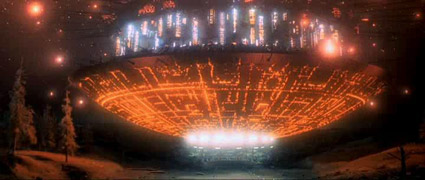
Spielberg's idea, OK. But here was a guy directly involved with the creation of that glorious movie moment and boy, did he have some stories. I'll end on my favourite, something you do not find in literature on the subject (because I've damn well read it all). On the edge of the mothership (where the dome underbelly, once landed, meets the cityscape in the middle) is a rim all around the model and all the artists and crafts persons who sweated blood to make that model's appearance so glorious had etched their names into the model itself – a role call of cinematic excellence. It was only many years later that I found another example of this 'signing' your work and it's only fitting it was in the shell of another beloved object – the original Macintosh Computer.
The main feature looks very good, practically dust and dirt free. If anything, it shows its age with film grain noticeable in certain shots. Presented in 2.35:1 anamorphic, the DD 5.1 soundtrack hasn't had any kind of a radical makeover but it's pretty good anyway. OK, it doesn't take full advantage of the state of the art "Let's re-mix and stun everyone" philosophy employed by Ridley Scott and his Blade Runner makeover but it's fine enough. We are talking about a 30 year old movie... But at some future date, expect another release (The Ultimate Collector's Edition, anyone?) with a fully re-mixed soundtrack.
A tad disappointing. However wonderful it is to have the three versions of the film in a definitive DVD (and soon to own Hi-Def) version, it's those two early cuts and one short interview with Spielberg that set this box set apart from the earlier Collector's Edition. This is no Blade Runner-esque radical overhaul (to be fair there are no real 'mistakes' in CE3K) and it feels good to – at last – have on DVD the original film that wowed me so much. It's never been available on DVD. So, Extras-wise, we're given the same as the Collector's Edition, slightly differently presented.
The Making of CE3K (101:42)
On disc one, the first part of The Making of CE3K directed by the Extras Doyen, Laurent Bouzereau. The other two parts are spread over the other two discs. This is a comprehensive trawl through the history of CE3K with comments from all the main players (sadly Truffaut died in 1984). Simply put, this is the ideal accompaniment to the movie, the nicest surprise of all to see how Carey Guffey (little Barry Guiler) has grown and now works in finance!
Watch The Skies (1977 featurette – 5:40)
On disc three, this is essentially the EPK (or 'electronic press kit') circa 1977. It does a good job of explaining what Columbia thought unexplainable – the ridiculous title! It has a triptych screen approach using lots of stills and for its short running time, it does the job. When I first saw it, it was a "Ah, so that's what Spielberg's been doing all this time!" It also managed to banish from my mind a disgusting image of a young director, fat, pushing junk food into his face, swimming in millions of dollars from his first and last big fat hit.
Steven Spielberg – 30 Years of Close Encounters (Interview – 21:22)
This contains a few, a very few, extra snippets of information not already in the public domain. It stinks a little of "What can we do to make this edition different from the Collector's Edition?" It's too little too late and has the faintest whiff of cynicism about it. What am I saying! This is the film industry!
30th Anniversary Ultimate Edition Trailer (1:31)
Just what it says on the tin.
So what's in the box?
- A small movie poster with the three versions' differences outlined on the reverse.
- A small booklet with lots of unpublished photos and some significant quotes.
- A ribbon that sits beneath the box set's contents so you can pull it up and release them... Jesus. I'd have preferred a tinfoil unicorn and a Spinner – oops, wrong movie.
If you already own the Collector's Edition of the movie with everything available from this box set except for the earlier two versions of the film and a short up to date Spielberg interview, then depending on what place in your heart CE3K nestles, you won't be surprised by any significant technical change unlike the Blade Runner Box Set released the same day. I have to have this latest release though. I hope now you understand why.
|